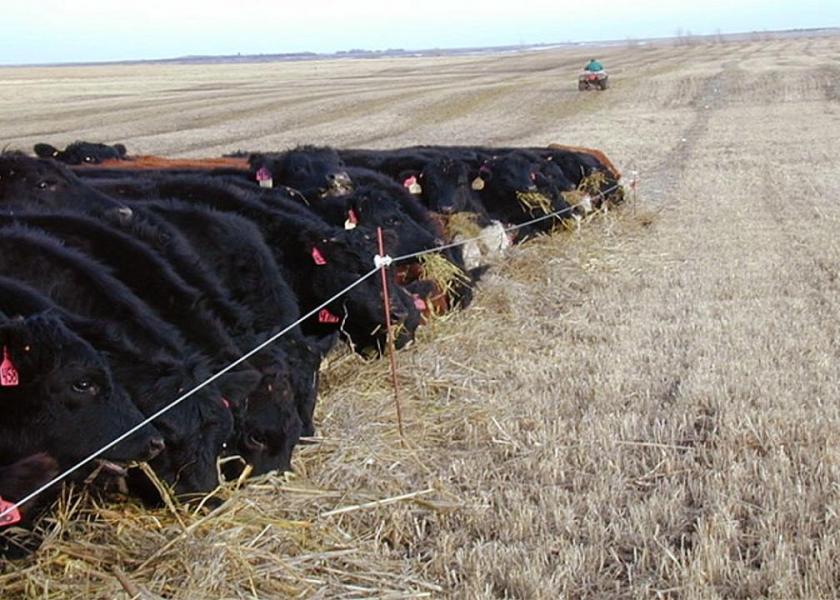Swath Grazing

By Adele Harty and Olivia Amundson
Feed makes up the largest expense on a cow/calf operation. In addition to the initial expense, producers need to consider the storage and waste associated with winter feeding in the northern United States. As expenses increase, and producers evaluate more-efficient management techniques to lower production costs, one alternative may be to incorporate swath, or windrow grazing. Swath grazing can be utilized with various crops and can improve utilization of the crops for feed, while decreasing fuel, harvest and feeding costs and also improving soil health.
Swath grazing is the practice of cutting hay, small grains or forage crops and leaving them in windrows for livestock to graze during the winter months. Rather than having the expense of baling the hay, moving it off the field and feeding it in the winter, the feed is left in windrows, and cattle are allowed access to a limited number of windrows at a time as a means to reduce winter feed costs and increase soil fertility.
Benefits of Swath Grazing
Swath grazing has its benefits in the Midwest, where colder temperatures and snow accumulation regularly occur. If utilizing a small grain crop, such as, but not limited to, millet, sudan or sorghum, swath grazing may provide an additional opportunity to utilize the forage.
A study conducted at Iowa State University evaluated forage quality and utilization of swath grazing on the cow herd. Millet and sorghum were harvested in late July as a hay crop, allowed to regrow, and the regrowth was cut and raked in late December for a swath grazing trial. Cows in their third trimester of gestation were moved from corn stalk residue to the swaths, where they grazed in a similar method to intensive grazing. Cows were given enough swaths to graze for three days at a time, and then fencing was moved and cows were given access to the next section. Cow behavior became similar to that of an intensive grazing system, as cows became trained and knew what to do when they were supposed to move. The logistics of moving fencing during the winter can be a challenge, depending on temperatures and the situation, so take that into consideration, as ground temperature will affect fencing being moved during the rotation.
The nutrient value of the feed did decline toward the end of February when cows were switched over to a TMR; however, they saw no detrimental effects to the calves as a result. Cows were able to utilize the feed with up to 12 inches of snow accumulation and temperatures of -20 degrees Fahrenheit. Forage utilization was up to 70%, which makes swath grazing a cost-effective option in comparison to putting the forage in bales. With swath grazing, operating equipment and labor decrease, as harvesting and moving bales or manure hauling are minimal. The study also found that grazing crop residue was minimal and did not affect regrowth of a perennial forage crop, thus allowing grazing to occur on a hay field or permanent pasture.
From a soil health perspective, swath grazing increases soil health through manure and urine distribution. In a dry year, it helps create a potential seedbed and improved filtration by breaking soil crust, fully trampling all the non-eaten materials, and spreading out dung piles, making them less fly friendly. This also provides a food source for soil microbes, thus increasing fertility of fields in the long-term.
Considerations of Swath Grazing
This can be a more labor-intensive method of grazing and mimics a management-intensive grazing system. The labor required is to move the cattle and fencing in relation to appropriate stocking density, but it is important to compare daily feeding of harvested forages to determine if there truly are labor differences. A reliable winter water source will be vital to the success of this system and could increase labor and time requirements.
It’s also important to consider animal performance for those animals that are utilizing the swaths. As the forage quality declines, this system may not be suitable for lactating cows, as their nutrient requirements are the highest. However, applying this method to cows in mid-to-late gestation, stocker calves or replacement females, could be a cost-effective and efficient alternative.







